Crypto perpetual contracts are on fire, why can't options keep up?
Written by Sumanth Neppalli and Joel John
Compiler: Luffy, Foresight News
Remember Sam Bankman-Fried? He worked at Jane Street and later became known for his "effective altruism" experiments and embezzlement. In the past month, Jane Street has been in the news for two things:
One is suspected of aiding the coup d'état (allegedly); The second is to conduct an arbitrage trade experiment in the Indian options market (again, allegedly, I can't afford to hire a lawyer who can beat them in court).
Some of these deals were so large that the Indian government decided to ban Jane Street from doing business in the country altogether and seized their funds. Matt Levine gives a brilliant overview of this in his Bloomberg column, and to make a long story short, here's how this "arbitrage" works:
-
Selling a put option in a liquid market (e.g., $100 million size);
-
Steadily go long on the underlying asset in a liquid market (e.g., $10 million per day).
In a market like India, options are often traded several times as much as the underlying stock. This is a market feature, not a loophole. Even if the underlying asset is insufficient, the market can always find liquidity. For example, the total volume of gold ETFs far exceeds the actual gold reserves; Another example is the 2022 Spike in GameStop's stock price, partly because its short positions outweighed the number of shares outstanding. Back to the case of Jane Street.
When you "buy" a put option, you are betting that the price will fall, or rather, you are buying the right to sell the asset at the agreed price (i.e. the strike price). Buying a call option is the opposite: you buy the right to buy an asset at a preset price. Let me use the upcoming PUMP token as an example.
Assuming I'm betting that the fully diluted valuation (FDV) of the PUMP token will be less than $4 billion at launch (probably out of antipathy to VC and the meme market), I'd buy a put. The ones who sold me the options were probably VCs with allocations of PUMP tokens who thought the price would be higher when they went live.
The VC firm that sells the put option receives a premium. Let's say I pay a $0.10 premium, if the token listing price is $3.10 and my strike price is $4, then I would make a profit of $0.90 on exercising the put option and an actual profit of $0.80 after deducting the premium. Venture capitalists, on the other hand, were forced to sell their tokens at a lower price than expected ($3.10), which equates to a $0.90 loss on the price difference.
Why should I do this? Because leverage is extremely high: if I put in $0.1, I can short $4 of an asset. Why can you get such a high leverage? Because the person who sells the option (VC) doesn't think the price will fall below $4. To make matters worse, VCs (and their networks) may buy PUMP at $4, ensuring that the price remains at $4.5 when exercised. This is exactly what the Indian government accused Jane Street of doing.
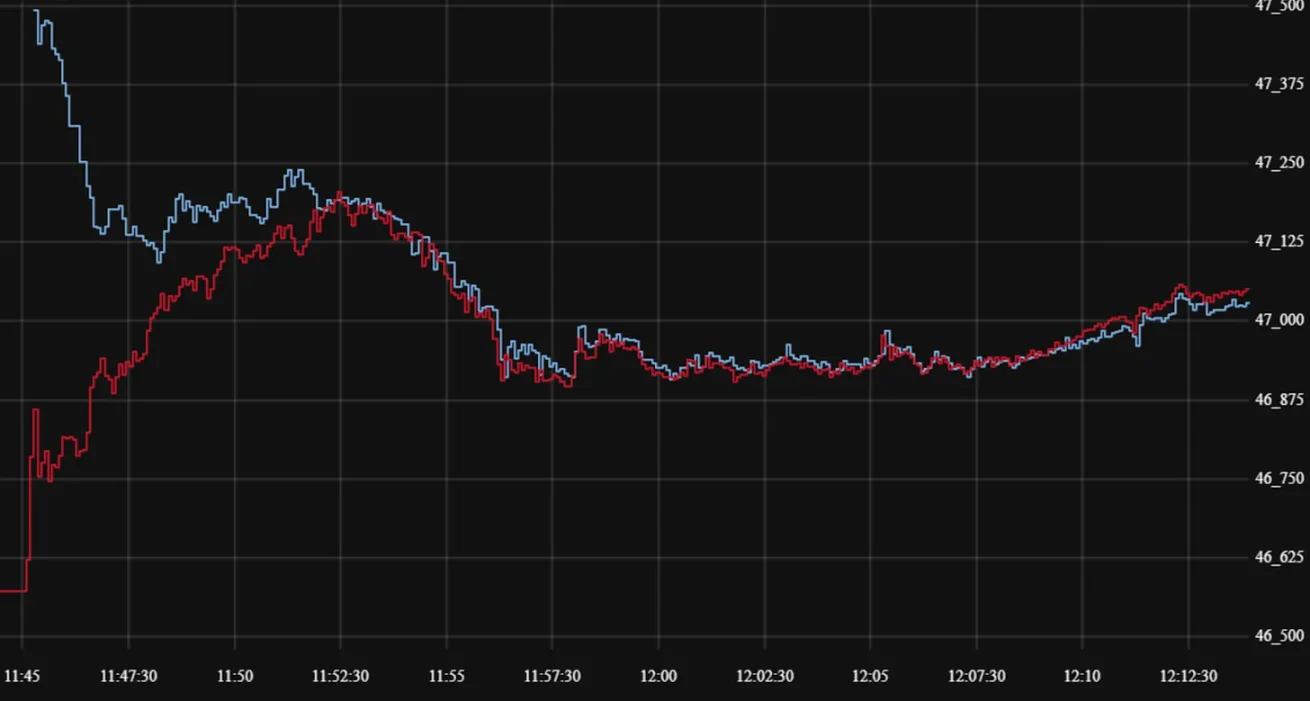
Source: Bloomberg
In Jane Street's case, though, they weren't trading PUMP tokens. They are trading Indian stocks, specifically, the NIFTY Bank Index. Due to the high leverage offered in this market, retail investors often trade options. All they have to do is do this: buy some of the relatively illiquid underlying stocks that make up the index.
Then, as the spot buy pushes up the index price, sell the index call option at a higher premium; Buy an index put option at the same time; Finally, sell the stock to pull the index down. Profits come from call premiums and put gains, and there may be small losses in spot trading, but put gains are usually more than enough to cover these losses.
The chart above illustrates how this trade works: the red line is the index trading price, and the blue line is the options trading price. In effect, they sell options (drive down prices, collect premiums) and buy the underlying asset (drive up prices, without paying for options) – all arbitrage.
What does this have to do with today's topic?
It doesn't matter. I just wanted to explain the concepts of puts, calls, and strikes to people who are new to these terms.
In this issue, Sumanth and I explore a simple question: Why hasn't the crypto options market exploded? With Hyperliquid leading the narrative, on-chain perpetual contracts are hot again, and stock perpetual contracts are about to go live, but what about options? As with most things, we start with the historical background, then analyze the details of how these markets work, and finally look to the future. Our assumption is that if perpetual contracts hold their ground, the options market will evolve with it.
The question is: which teams are developing options products? What mechanics will they employ to avoid repeating the mistakes of the 2021 DeFi Summer?
We don't have a definitive answer yet, but we can provide some clues.
Perpetual contract puzzles
Remember that pandemic? It was a "good time" when we sat at home, speculating about how long this mass social distancing experiment would last. It was also at that time that we saw the limitations of the perpetual contract market. Like many commodities, there is a futures market for oil, where traders can bet on its price. But like all commodities, oil is only valuable when it's in demand. Pandemic-induced restrictions have led to a sharp drop in demand for oil and related products.
When you buy physically delivered futures (non-cash settlement), you gain the right to receive the underlying asset at an agreed price in the future. So, if I'm long oil, I'll "receive" the oil when the contract expires. Most traders don't actually hold the commodity, but sell it to factories or counterparties that have the logistical capacity (e.g., tank trucks).
But in 2020, things got out of hand. No one wants that much oil, and traders who buy futures contracts have to take custody of them. Imagine: I'm a 27-year-old analyst at an investment bank, but I'm going to receive 1 million gallons of oil; A compliance executive in my 40s would definitely let me sell it all first. And that's exactly what happened.
In 2020, oil prices fell to negative territory at one point. This vividly illustrates the limitations of physical futures: you have to receive the goods, and there is a cost to receive them. If I'm just a trader betting on the price of oil, chicken, or coffee beans, why would I want to receive a physical thing? How do I ship goods from origin to Dubai port? This is precisely the structural difference between crypto futures and traditional futures.
In the world of cryptocurrency, there is almost no cost to receive the underlying asset: just go to the wallet.
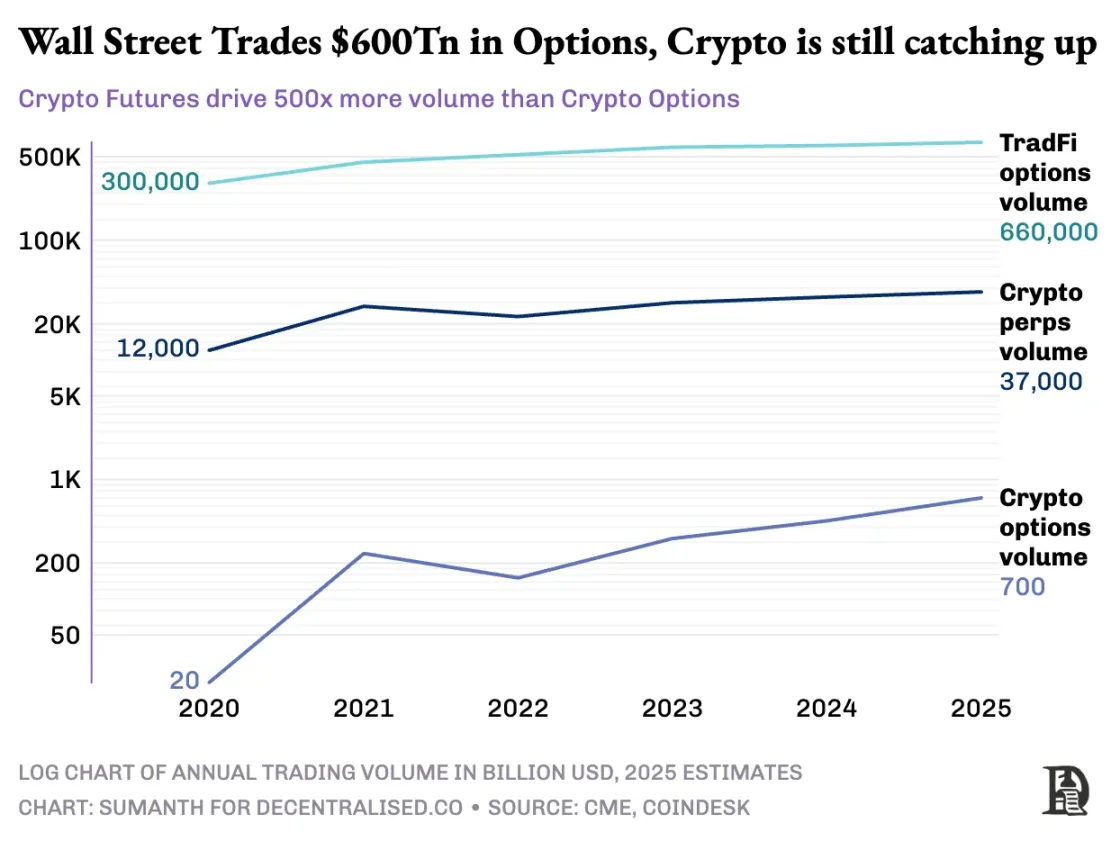
However, the crypto options market has never really exploded. In 2020, the U.S. options market traded about 7 billion contracts; Today, that number is close to 12 billion copies, with a nominal value of about $45 trillion. The U.S. options market is about 7 times the size of the futures market, with nearly half of those trades coming from retail investors who are keen on short-term options that expire on the same day or over the weekend. Robinhood's business model is based on this: providing fast, convenient, and free access to options trading, and monetizing through a "pay-for-order flow" model (paid by market makers like Citadel).
But the situation with crypto derivatives is very different: perpetual contracts are traded at about $2 trillion per month, which is 20 times higher than options (about $100 billion per month). Instead of inheriting the existing model of traditional finance, the cryptocurrency market has built its own ecosystem from scratch.
The regulatory environment shapes this difference. Traditional markets are subject to the U.S. Commodity Futures Trading Commission (CFTC), which requires futures rollovers, bringing operational friction; U.S. regulations limit the leverage on stock margin at about 2x, and also prohibit "20x perpetual contracts". As a result, options become the only way for Robinhood users (such as retail investors with as little as $500) to convert a 1% move in Apple stock into a gain of more than 10%.
The unregulated environment of cryptocurrencies creates room for innovation. It all started with BitMEX's Perpetual Futures: As the name suggests, these futures have no 'delivery' date and are permanent. You don't need to hold the underlying asset, you just trade it over and over again. Why do traders use perpetual contracts? Two reasons:
-
Compared with spot trading, perpetual contracts have lower handling fees;
-
Perpetual contracts have higher leverage.
Most traders like the simplicity of perpetual contracts. In contrast, options trading requires understanding multiple variables at the same time: strike price selection, underlying asset price, time decay, implied volatility, and delta hedging. Most crypto traders transition directly from spot trading to perpetual contracts, skipping the learning curve of options entirely.
In 2016, BitMEX launched perpetual contracts, which instantly became the preferred leverage tool for crypto traders. In the same year, a small Dutch team launched Deribit, the first trading platform focused on crypto options. At the time, Bitcoin was trading below $1,000, and most traders thought the options were too complicated to be necessary. Twelve months later, the wind changed direction: Bitcoin soared to $20,000, and miners with huge inventories began buying put options to lock in profits. In 2019, Ethereum options went live; By January 2020, options open interest topped $1 billion for the first time.
Today, Deribit handles more than 85% of the crypto options trading volume, which shows that the market is still very concentrated. When institutions need a large transaction, they don't opt for an order book, but instead contact the inquiry desk or communicate on Telegram, and then settle through the Deribit interface. A quarter of Deribit's trading volume comes from this private channel, highlighting the dominance of institutions in this seemingly retail-dominated market.
Deribit is unique in that it allows for cross-market staking. For example, you go long futures ($100,000 in Bitcoin) and buy $95,000 in put options. If the price of Bitcoin falls, futures longs will lose money, but the increase in the value of the put option will avoid liquidation. Of course, there are a lot of variables here, such as option expiration time or futures leverage, but Deribit's cross-market collateralization feature is a key reason for its dominance.
Theoretically, on-chain options make this easy to achieve: smart contracts can track strike prices and expiration dates, escrow collateral, and settle yields without intermediaries. However, after five years of experimentation, the total trading volume of decentralized options exchanges is still less than 1% of the options market, while perpetual contract decentralized exchanges account for about 10% of futures trading volume.
To understand why, we need to review the three stages of on-chain options.
Options of the Stone Age
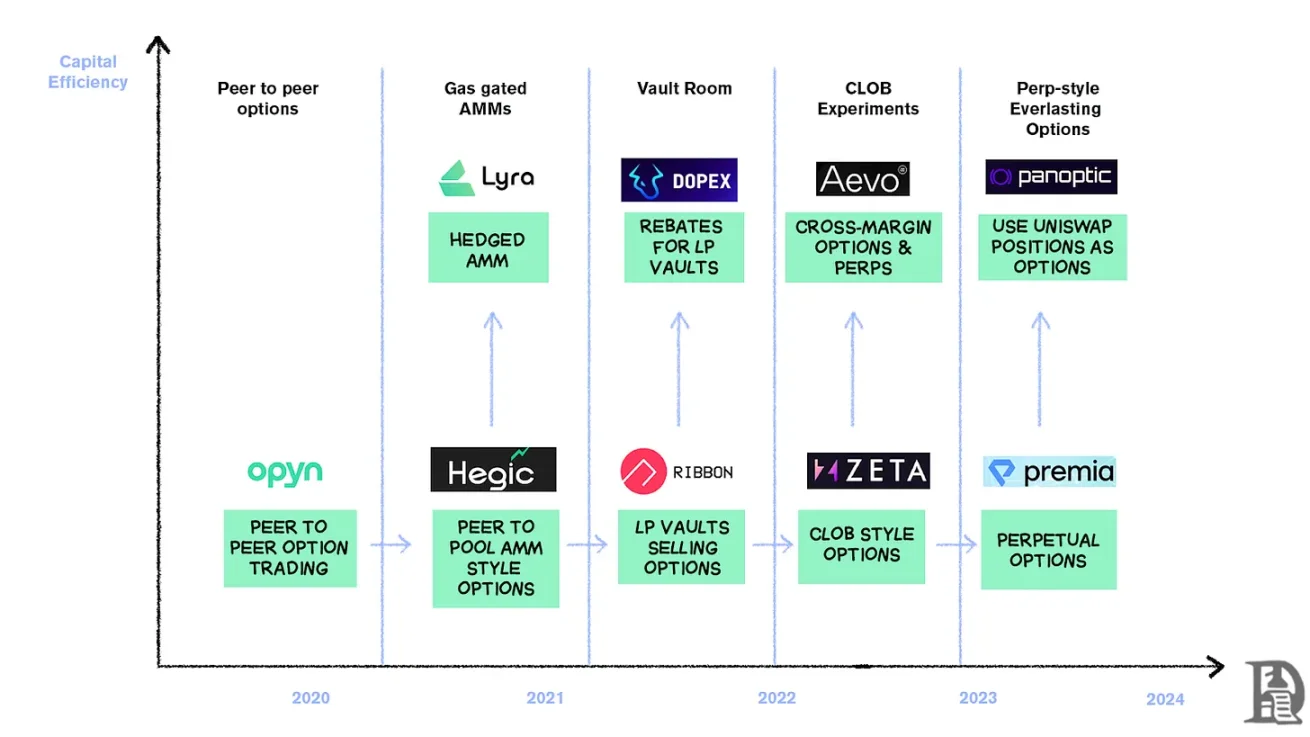
In March 2020, Opyn democratized options issuance: locking ETH as collateral, choosing the strike price and expiration date, and the smart contract minted ERC20 tokens representing the rights. These tokens can be traded on any platform that supports ERC20: Uniswap, SushiSwap, or even direct wallet transfers.
Each option is a separate tradable token: the July $1000 call option is one token and the $1200 call option is another, which results in a fragmented user experience but the market functioning. At expiry, the holder of the "in-the-money" option can exercise the option for a profit, and the contract returns the remaining collateral to the seller. To make matters worse, the seller must lock in the full notional value: if you sell a 10 ETH call option, you need to freeze 10 ETH until it expires in order to earn a premium of 0.5 ETH.
This system worked well until the arrival of DeFi Summer. When gas fees soar to $50-$200 per transaction, the cost of issuing an option often exceeds the premium itself, and the whole model collapses almost overnight.
Developers are turning to a Uniswap-style liquidity pool model. Hegic has spearheaded this change, allowing anyone, from retail investors to whales, to deposit ETH into public vaults. Liquidity providers (LPs) pool collateral into a pool, and smart contracts quote options for buying and selling. Hegic's interface allows users to select the strike price and expiration date.
If a trader wants to buy a 1 ETH call option for the next week, the automated market maker (AMM) will price it with a Black-Scholes model, taking ETH volatility data from an external oracle. After the trader clicks "Buy", the contract will dedicate 1 ETH from the pool as collateral, mint an NFT that records the strike price and expiration date, and send it directly to the buyer's wallet. Buyers can resell NFTs on OpenSea at any time, or wait for them to expire.
For users, it's almost magic: a transaction is completed without a counterparty, and the royalties go to the LPs (minus the protocol fee). Traders like the one-click experience, while LPs like profits; The vault can issue options with multiple strike/expiration dates at the same time without the need for active management.
This magic lasted until September 2020. Ethereum experienced a violent crash, and Hegic's simple pricing rules caused put options to sell too cheaply. Put option holders exercised, forcing the vault to pay far more ETH than expected. In just one week, a year's worth of premium returns were wiped out, and LPs learned the hard way: issuing options in a calm market may seem easy, but without proper risk management, a storm can wipe it all out.
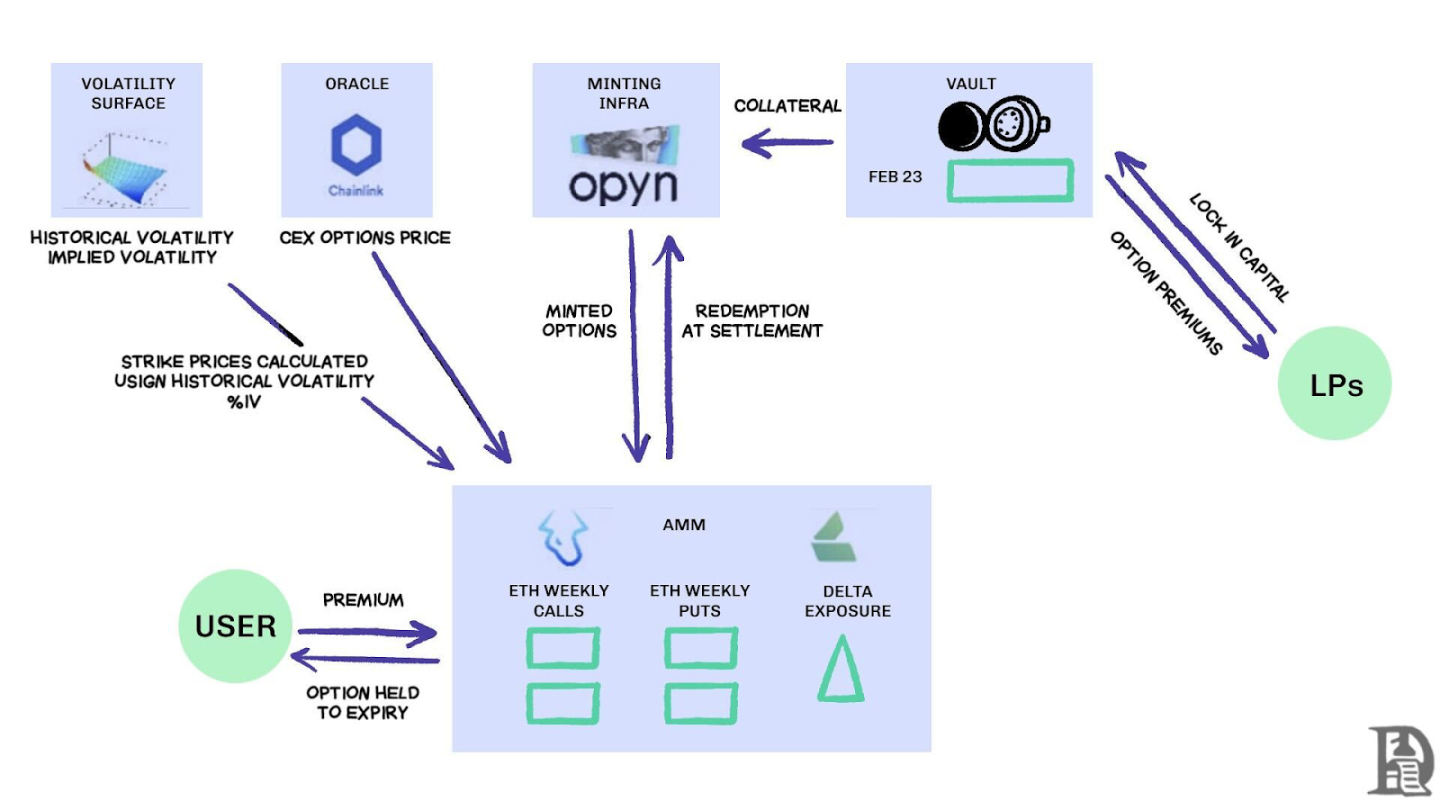
AMMs must lock in collateral in order to underwrite options
Lyra (now Derive) tries to solve this problem by combining liquidity pools and automated risk management: after each trade, Lyra calculates the pool's net delta exposure (the sum of all strike and expiration delta options). If the vault has a net short exposure of 40 ETH, it means that for every $1 increase in the ETH price, the vault loses $40. Lyra will open a long position of 40 ETH on the Synthetix perpetual contract to hedge directional risk.
AMMs use the Black-Scholes model for pricing, handing over expensive on-chain computation to off-chain oracles to control gas fees. This delta hedging halves vault losses compared to unhedged strategies. Despite its clever design, the system relies on Synthetix's liquidity.
When the Terra Luna crash sparked panic and traders withdrew from the Synthetix staking pool, liquidity dried up causing Lyra's hedging costs to soar and spreads widened significantly. Complex hedging requires deep sources of liquidity, and DeFi has struggled to reliably provide this to date.
Look for the tinder
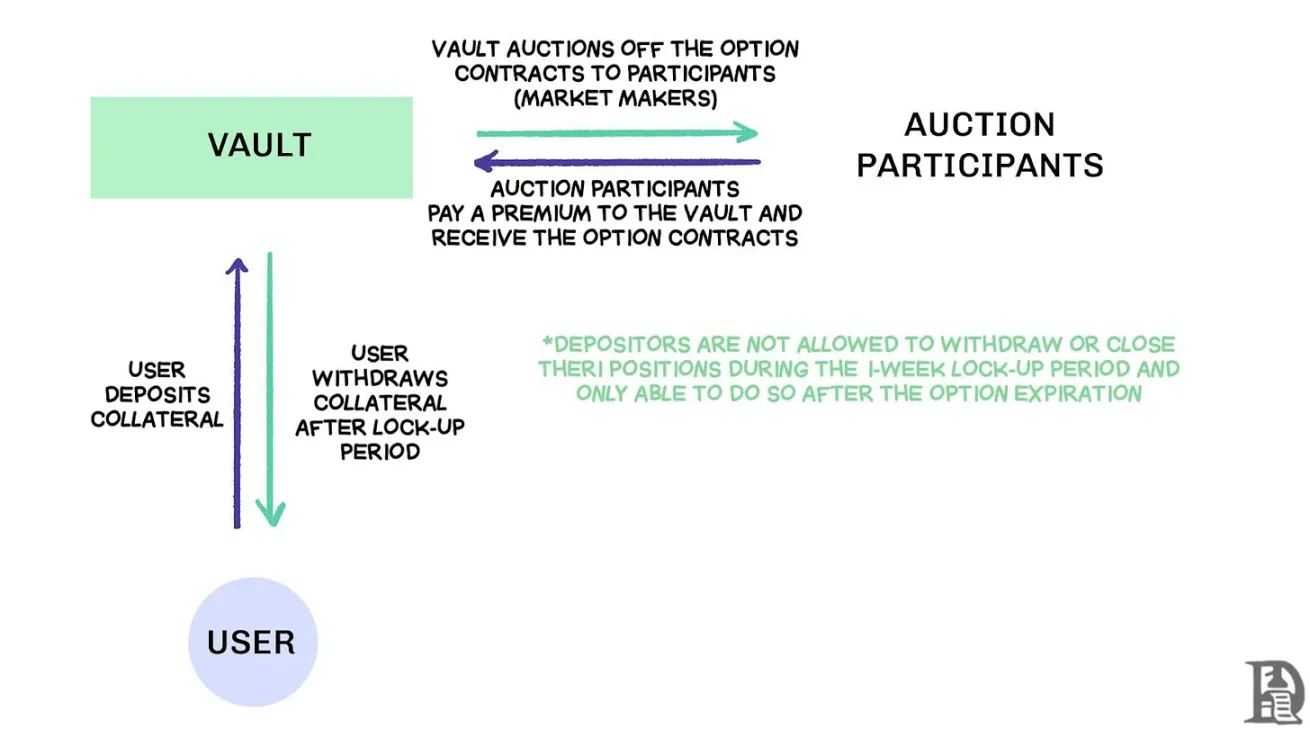
Decentralized Option Vaults (DOVs) sell order flow via auction, source: Treehouse Research
In early 2021, decentralized option vaults (DOVs) emerged. Ribbon Finance pioneered this model with a simple strategy: users deposit ETH into a vault and sell covered call options through an off-chain auction every Friday. The market maker bids on the order flow, and the premium is returned to the depositor as income. Every Thursday, after the options are settled and the collateral is unlocked, the whole process is reset.
During the 2021 bull market, implied volatility (IV) remained above 90%, and weekly premiums translated into staggering annualized returns (APYs). Weekly auctions continue to generate significant returns, and depositors enjoy seemingly risk-free ETH yields. But when the market peaked in November and ETH started to fall, the vault began to experience negative returns, and the royalty income was not enough to cover the decline in ETH.
Rivals Dopex and ThetaNuts replicated this model and added rebate tokens to cushion the impact of periods of loss, but still failed to address the core vulnerabilities to deal with large volatility. In both AMM and DOV models, funds are locked until maturity. Users who deposit ETH to earn a premium will be stuck when ETH falls and will not be able to close their positions when needed.
Order book

The Solana ecosystem team took a very different approach, taking a very different approach by learning the lessons of the limitations of AMMs in earlier option agreements. They sought to replicate Deribit's Central Limit Order Book (CLOB) model on-chain, with a sophisticated order matching engine for near-instant settlement, and the introduction of a market maker as the sell-side counterparty to each option.
First-generation products such as PsyOptions try to put the order book entirely on-chain, where each quote takes up block space and market makers have to lock up 100% of the collateral, so quotes are scarce. Second-generation products such as Drift and Zeta Markets move the order book off-chain and match it before settling on-chain. The Ribbon team returns to the battlefield with Aevo, putting the order book and matching engine on the high-performance Optimism Layer 2.
What's more, these products support perpetual contracts and options on the same platform, and are equipped with a portfolio margin system that calculates the net exposure of market makers. This is the same success factor as Deribit, allowing market makers to reuse collateral.
The results were mixed. Spreads are narrowed as market makers can update quotes frequently without paying high gas fees. But the weakness of the CLOB model manifests itself during non-trading hours: when professional market makers in the U.S. go offline, liquidity evaporates, and retail traders face huge spreads and poor execution prices. This reliance on active market makers has led to temporary "dead zones", which has never been the case with AMMs, despite their flaws. Teams like Drift have switched entirely to perpetual contracts, ditching options.
Teams such as Premia explore the AMM-CLOB hybrid model, finding a middle ground between a full-chain order book that provides 24/7 liquidity and a market maker that adds depth. However, the total value locked (TVL) never exceeded $10 million, and large transactions still required market maker intervention, and slippage remained high.
Why options are struggling
Options liquidity is flowing from the AMM to the order book. Derive deactivated the on-chain AMM, rebuilt the exchange around the order book, and equipped it with a cross-margin risk engine. This upgrade attracted the likes of Galaxy and GSR, and the platform now handles about 60% of on-chain options trading volume, making it the largest decentralized options exchange in DeFi.

Vlad talks about limit order book design
When a market maker sells a $120,000 BTC call option and hedges it with spot BTC, the system identifies these offset positions and calculates margin requirements based on net portfolio risk rather than individual position requirements. The engine continuously evaluates each position: underwriting $120,000 call options expiring in January 2026, shorting next week's weekly contract, buying spot BTC, and requiring traders to post margin based on net directional exposure.
Hedging offsets risk, freeing up collateral to redeploy into the next quote.
On-chain protocols break this cycle when they tokenize each strike price and expiration date into their respective ERC-20 token pools. The 120,000 call options minted next Friday do not identify hedging of the BTC perpetual contract. While Derive has partially solved this problem by adding perpetual contracts within its clearing house to enable cross-margining, the spread is still much higher than Deribit's; The spread for the same position is usually 2-5 times higher.
Note: Let's explain it with the price of mango. Let's say I sell someone the right to buy a mango for $10 and charge a $1 premium. These mangoes ripen after three days. As long as I have mangoes (spot assets), I can receive a premium ($1) and don't have to worry about the market price of mangoes going up.
I wouldn't lose money (hence the hedge) unless there is an opportunity cost to the rise in mango prices. If Sumanth had bought the option (paying me $1), he could have turned around and sold the mango for $15, netting $4 after deducting the premium. These three days are the expiration date of the option. At the end of the deal, I either still hold the mango or get a total of $11 ($10 mango money + $1 premium).
On a centralized exchange, my mango farm and market are in the same town, and they know the security of my transaction, so I can use the premium paid by Sumanth as collateral to offset other expenses (such as labor fees). But in the on-chain market, the two markets are theoretically located in different locations and do not trust each other. Since most markets rely on credit and trust, this model is capital inefficient – I could have lost money just by passing Sumanth's payments to carriers.
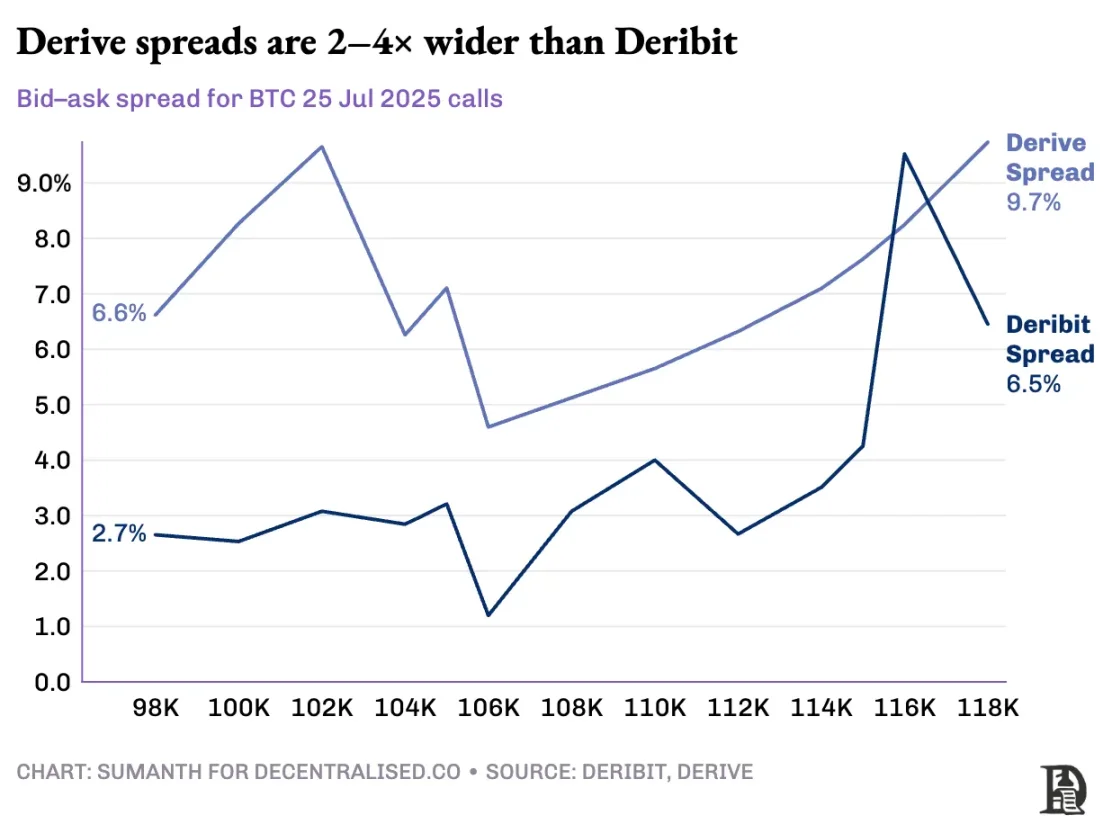
Deribit benefits from years of API development, as well as numerous algorithmic trading platforms with systems optimized for their platforms. Derive's risk engine has only been online for just over a year and lacks the large order book needed to effectively hedge the spot and perpetual contract markets. Market makers need instant access to the deep liquidity of multiple instruments to manage risk, and they need to be able to hold options positions at the same time and easily hedge them with perpetual contracts.
Perpetual contracts: Decentralized exchanges solve the liquidity puzzle by completely eliminating fragmentation. All perpetual contracts for the same asset are the same: a deep pool, a funding rate, and the liquidity is uniform regardless of whether the trader chooses 2x or 100x leverage. Leverage only affects margin requirements and does not affect the market structure.
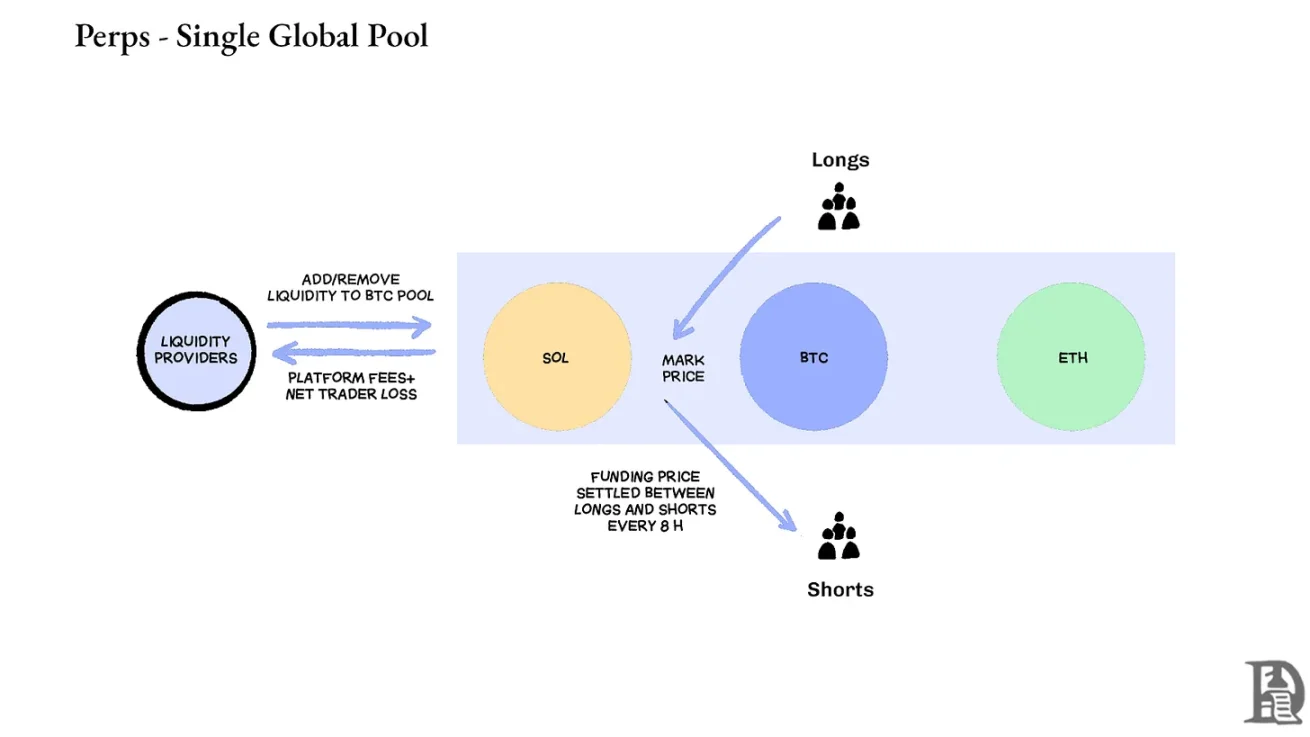
This design has led to significant success for platforms such as Hyperliquid: their vaults are often counterparties to retail trades, distributing transaction fees to treasury payers.
In contrast, options disperse liquidity across thousands of "micro-assets": each strike-expiration portfolio forms a separate market with unique characteristics that result in diversification that is nearly impossible to reach the depth required by sophisticated traders. This is the core reason why on-chain options failed to take off. However, given the liquidity that is surging on Hyperliquid, this could change soon.
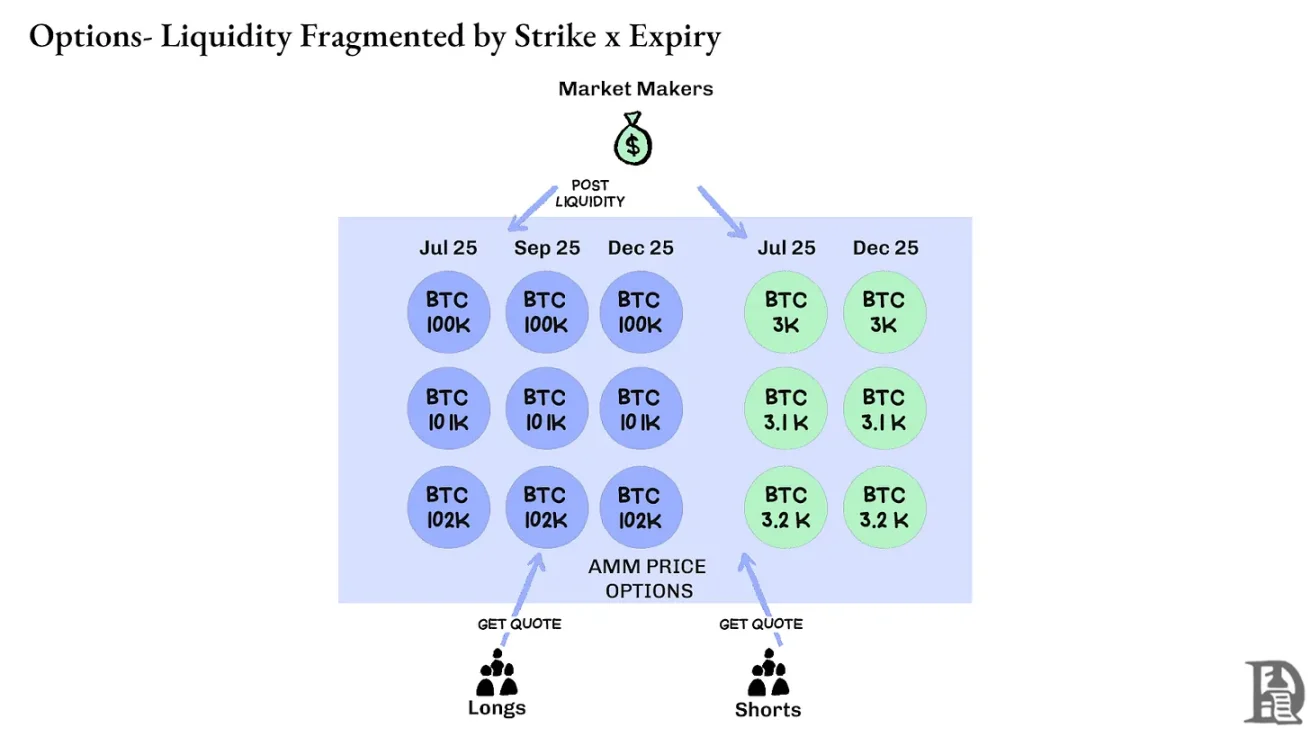
The future of crypto options
Looking back at the rollouts of all major option agreements over the past three years, a clear pattern emerges: capital efficiency determines survival. Protocols that force traders to lock in separate collateral for each position, no matter how complex their pricing models and smooth interfaces, end up losing liquidity.
Professional market makers have extremely thin profit margins, and they need every penny to work efficiently in multiple positions. If an agreement requires them to post $100,000 collateral for a Bitcoin call option and $100,000 for the perpetual contract used for hedging, rather than treating this collateral as an offsetting risk (perhaps as little as $20,000 net margin), then it is not profitable to participate in the market. To put it simply: no one wants to lock up a large amount of money and make only a little money.
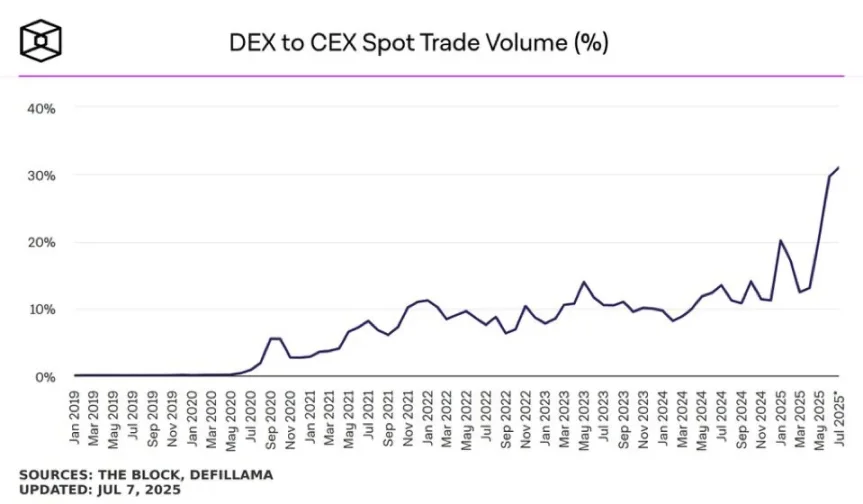
Source: TheBlock
The spot market on platforms such as Uniswap often has a daily trading volume of more than $1 billion with minimal slippage; Perpetual contract decentralized exchanges such as Hyperliquid process hundreds of millions of dollars in trading volume every day, and spreads can compete with centralized exchanges. The much-needed liquidity base for option protocols now exists.
The bottleneck is always the infrastructure: the "pipes" that professional traders take for granted. Market makers need deep liquidity pools, instant hedging capabilities, instant liquidation in the event of a deterioration in positions, and a unified margin system that treats the entire portfolio as a single exposure.
We've written about Hyperliquid's shared infrastructure approach, which creates a positive-sum state that DeFi promises for a long time but rarely delivers: each new application strengthens the entire ecosystem, rather than competing for scarce liquidity.
We believe that options will eventually come on-chain through this "infrastructure-first" approach. While early attempts focused on mathematical complexity or clever tokenomics, HyperEVM solves the core "pipeline" problem: unified collateral management, atomic-level execution, deep liquidity, and instant liquidation.
We see several core areas of changing market dynamics:
-
After the collapse of FTX in 2022, there were fewer market makers participating in the new primitives and taking risks; Today, traditional institutional players are returning to the cryptocurrency market.
-
There are more proven networks that can meet the demand for higher transaction throughput.
-
The market is more receptive to partial logic and incomplete liquidity on the chain.
If options are to return, three types of talent may be needed: developers who understand how the product works, experts who understand market maker incentives, and people who can package these tools as retail-friendly products. Can on-chain options platforms allow some people to earn life-changing wealth? After all, Memecoin has done it – and they have made the dream of making millions with a few hundred dollars a reality. Memecoin's high volatility makes it work, but lacks the "Lindy effect" (which becomes more stable the longer it exists).
In contrast, options have both the Lindy effect and volatility, but are difficult for the average person to understand. We believe there will be a class of consumer applications focused on bridging this gap.
Today's crypto options market is similar to what it was before the Chicago Mercantile Exchange (CBOE) was founded: a bunch of experiments, a lack of standardization, and speculation rather than hedging. But that will change as the crypto infrastructure matures and becomes commercially operational. Institutional-grade liquidity will be on-chain through reliable infrastructure, supporting cross-margin systems and composable hedging mechanisms.
